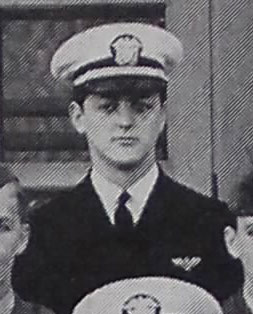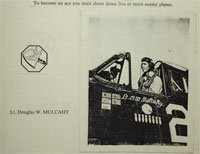|
Cabot, Yap, Russell, J.B., Lt(jg)
VT-31 History for 27 July 1944: Strikes launched against Yap Island. A TBM flown by Lt. Russell was hit by flack while approaching the target. The fuel tanks were breached and the aircraft set ablaze. He succeeded in dropping his four 100lb bombs on the target and headed out over water where Russell was able to hold the crippled Avenger in the air long enough for the crew bail out just off shore. The shore batteries opened fire on the downed plane crew but were unable to lower their guns enough and they fired over them. The covering F6Fs from VF-31 proceeded to make short order of the shore batteries and flew overhead until an OS2U Kingfisher from the cruiser USS Columbia (CL-56) arrived and picked up the wounded men. Pilot Lt. (jg) Russell along with crewmen AMM2c Bennett and PhoMlc Webster, were taken to the destroyer USS Brown (DD 546) and returned to Cabot. All three men were awarded Purple Hearts. Information from: www.vf31.com
VF-1 Action Report: Comdr. PETER's section was waiting its turn at the target wehen a TBF was shot down by A.A. and he began to direct rescue operations. The three TBF survivors were just outside the reef off the southeastern shore of the island. Read completed report at:  VF-1 Action Report: Rescue operation for TBF crew VF-1 Action Report: Rescue operation for TBF crew
The following data was located at: www.mcallen.lib.tx.us TBM #1 missing from
strike on Yap, but picked up by USS Brown
(DD 546) and returned Lt. (jg) J. B. RUSSELL
and crewmen W. M. BENNETT, AMM2c and
H. M. WEBSTER, PhoMlc.
On 5 Sept. Russell, J.B., Lt(jg) was presented the Purple Heart award by Captain S.J. MICHAEL.
On 15 Sept. Russell, J.B., Lt(jg) was presented the The Navy Cross award by Captain S.J. MICHAEL.
24 July, the Group approaching Woleai
Island. Lt. (jg)? R. O. ZIMMERMAN made a
barrier crash landing with no personal injuries.
25 July, the Force bombed and strafed Ulithi
Atoll and on the 26th, TBM #1 missing from
strike on Yap, but picked up by USS Brown
(DD 546) and returned Lt. (jg) J. B. RUSSELL
and crewmen W. M. BENNETT, AMM2c and
H. M. WEBSTER, PhoMlc.
The following account about the July 26-27 attack on Yap is from World War II Journal of Lawrence James Kennedy, Jr at: www.its.caltech.edu
The next day I got in my first mission. We struck Yap bombing a radio station there. The flight was routine, and not bad at all. Anti-aircraft fire was light and limited to small stuff. I learned one lesson that I’ll never forget in a hurry though. As I started to strafe on the pullout, both guns jammed – with a ruptured cartridge in each chamber. There was no way to correct it, except to strip down the guns and reset the head space. It was a tale with a happy ending, but it would have been just too bad if I had been jumped. Morale: Strip down your guns every time you leave the deck and reassemble them yourself. Then you know they will fire!!
The entire flight seemed so simple, so unopposed and so much like training that I was quite anxious to get in another flight if possible during the afternoon. Imagine, then my surprise to learn that one bomber from another squadron accompanying us was shot down as he pulled out and made a water landing offshore. Fortunately he was soon rescued by an OS2U which landed under fire in the water next to it. But that afternoon I was even more sobered by one of our own planes which dove into the ground where it exploded. This hit home rather hard, for he, the gunner, was one of the few men aboard whom I know. He was one of three men transferred into this squadron on July
Avenger crew rescue by Kingfisher: Story about a VS-310 Kingfisher from the cruiser Columbia saving three American airmen from an Avenger on 27 July 1944 in the Yap harbour.
It is the latter that we selected to present the OS2U Kingfisher. The people of Yaptown, Yap Island in the Carolines, basked in a pleasant, typical Pacific morning sun on the 27th of July 1944. The big harbor was peaceful; only an occasional whitecap broke the monotony of its surface. Overhead were scattered, fluffy cumulus clouds, cotton-balls hanging listlessly in the rich blue sky. Then, Task Force 58 with its 125 ships of the line (sixteen carriers) struck from fifty miles away. Around mid-day Avengers and Heilcats of VT-31 and VF-31 from the carrier Cabot struck Yaptown from the inland side of the city. The Avengers, each armed with four 100 pound general purpose bombs, made their bomb runs from 15,000 feet dropping down over the target then levelling off at 500 feet as they raced out over the harbor.
In mid-run to target a TBM of VT-31 is hit in the main fuel tank by flak. The pilot drops his bombs. The cockpit is burning. Still he holds the big ship at 500 feet until his two crewmen finally clear their aft compartment, which is also burning. Only then does the pilot leave the burning aircraft. Three are burned and down in the harbor. The enemy shore installations begin firing on them, but the shots pass overhead. The guns cannot be depressed low enough to get them, and the three are just beyond the range of smaller weapons. While VF-31 Heilcats go to work strafing the shore batteries, a call is Hashed to the anti-sub patrol for a Kingfisher.
Within minutes a Kingfisher from the cruiser Columbia was on the scene, its pilot bringing the aircraft in low and straight for the wounded Avenger crewmen. Now the shore batteries took him on as a target. The water came alive from exploding shells, still the OS2U came on to the men. After loading the TBM's pilot into the rear seat, his two crewmen sat on the wings and held on. The OS2U pilot would now dash over the water for the pick-up submarine five miles away. On the way out the Kingfisher pilot must pass through the entire effective range of the guns on the beach- and it is this section of the action that you see in the painting.
The end of the story is that thanks to a Kingfisher and her pilot and radioman-gunner, three more American lives were saved. After the long taxi to the submarine, the two Avenger-enlisted crew members were transferred. Then, with the Avenger pilot still snuggled down in the rear seat and its usual occupant setting astride the fuselage just behind him, the OS2U pilot took off for a rendezvous with the Columbia.
The information above was located from http://www.fiddlersgreen.net/index.php?pg=577
The following passage was provided by Mike from the VF-31 web site
I have found this passage in one of the officers memoirs (the beast was Lt Russell's nickname):
July 26.
Strike Yap. Flack not very much but what there was of it, was very accurate. After all, we are giving them plenty of practice.
The Beast was hit again. "I had just finished my run and was turning so that Webster (PhotoMate 1/c) could get some pictures. I felt a thud and the plane was tossed up a few feet then came an explosion and I knew we were hit. I climbed and headed out to sea as we were very close to the island".
Webster - "When I hear the noise, thought it was Bennett shooting because it was only a slight jar. but then there was an explosion, it knocked Bennett out of his turret and when I saw him standing beside me, we knew we were hit. Then the flames came. They blew back from the amidships radio compartment and I picked up the mike and told Mr.
Russell we were on fire. By now I had my chute hooked on and Bennett had jettisoned the hatch. There was a solid sheet of flame outside."
"Bennett's radio cord was caught so I kicked it loose and shoved him out, then followed. Chute opened easily and I looked up and saw Mr.
Russell leaving the cockpit. We were about over the reef so I slipped the chute seaward. the Japs began shooting at us but the range was too great and their stuff fell short. A TBF circled over head and dropped a raft, Bennett got the raft inflated and we helped Mr.
Russell on as he couldn't see very well. We had just started paddling when the first shell dropped. It was short about a hundred yards but the next one was closer. The next one was long and went over our heads. I figured they would have the range on the next one and it would plop right on us but it didn't happen. All the rest were long, their gunnery was poor, fortunately. About then some F6Fs appeared overhead, saw what was going on and made runs on the guns which stopped the shooting."
Russell - "Webster called and said that we were on fire and burning badly. The cockpit filled with smoke but at first the flames weren't too bad. But the smoke choked and gagged me and burned my eyes. I kept calling to the crew to bail out but got no answer. the fire began to burn my feet then my hands. The throttle was too hot to hold but I kept the airplane straight and level as long as I could to give Bennett and Webster a chance to get out. The airplane was like an inferno, didn't realize an airplane could burn like that one did. I held it as long as I could, then I couldn't stand the heat any longer and figured if they are not out yet, it's them or me and I went over the side. I landed close to the raft and after some fighters stopped the shelling an OS2U picked us up, got us to a destroyer and eventually back on the Cabot."
Pictures of the rescue of the Russell crew by Kingfisher from the cruiser Columbia
Click on a thumbnail image below to view the full sized image.
Overview of Russell Crew Rescue and Navy Ads about Rescue
Click on a thumbnail image below to view the full sized image.
Pictures of Lt. Russell
Click on a thumbnail image below to view the full sized image.
Pictures of Warren. M. Bennett
Click on a thumbnail image below to view the full sized image.
Howard M. Webster Jr. from Grayslake, IL. Photographer.
Click on a thumbnail image below to view the full sized image.
April 20, 2003 Obit for Howard Webster:Howard M. Webster Jr., 82, formerly of Lake Villa, IL, and CA. Loving father of Dan (Chris) Webster of Hayward, CA, Marilyn Webster of Burlington, WI, and Jeannie Schwieger of Round Lake Beach, IL; cherished grandfather of Tina and Jeff Webster and Michael (Cyndy) Schwieger; great-grandfather of Taylor Cruz, Haley Jones and Cody Schwieger; brother of Mary Jane Chambers and late Dorothy Darfler; many nieces and nephews. He fought in the Pacific Theatre in World War II. He served in the Navy aboard the aircraft carrier, USS Cabot, 1943-1944. He was the squadron photographer and flew as tail gunner in a TBM Avenger torpedo bomber in 'Torpedo Squadron 31'. Memorial visitation will be held from 2 to 6 p.m., Sunday, May 4, 2003, at Ringa Funeral Home, 122 S. Rte. 83, Lake Villa, IL, 60046 (2 blks S. of Rte. 132). Graveside services with military honors were held in CA. In lieu of flowers, memorials of your choice would be appreciated in his memory.
Pictures of Air Group 31 on the USS Cabot
Click on a thumbnail image below to view the full sized image.
| 






































































 PIN IT
PIN IT